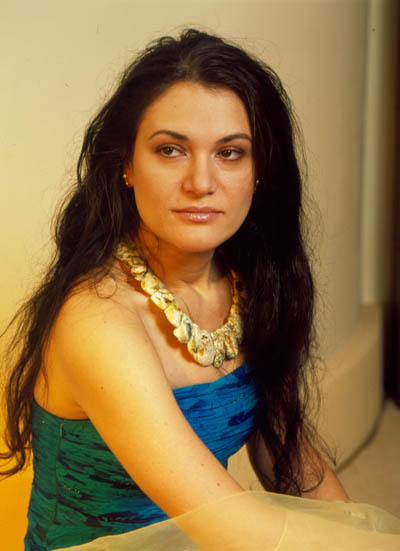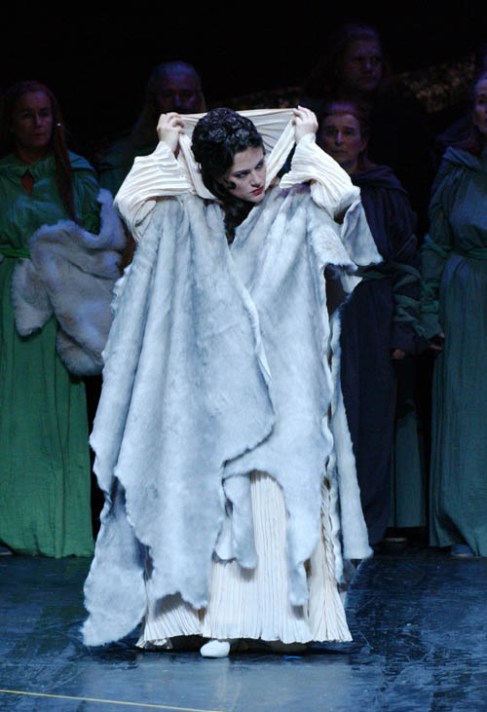
Soprano Mlada Khudoley tackles one of opera’s most challenging roles in S. Fla. production of ‘Norma’
When Mlada Khudoley makes her debut as Vincenzo Bellini’s “Norma” with the Florida Grand Opera on Jan. 23, the young Muscovite soprano, who already has the roles of Sieglinde, Senta, Renata, Turandot, Cassandre, Aïda, Abigail and Richard Strauss’ Empress under her belt, will be facing her greatest test–measuring up to the ghosts of Norma’s past.

Mlada Khudoley.
Playing the famous Druid priestess poses the supreme challenge. The opera is the apex of the bel canto repertoire and a musical milestone in which styles converged. It marked a turning point in the history of the genre, as well as in the 30-year-old Bellini’s career, as it does in the career of every singer who tackles it. It combined the classical and the romantic; the legacy of Wolfgang Mozart, Christoph Willibald Glück and Gaspare Spontini; the present that then was Gioachino Rossini, Gaetano Donizetti and Saverio Mercadante; and the future represented by Giuseppe Verdi, Hector Berlioz and even Richard Wagner, who revered it as he did no other Italian opera.
The pivotal Norma character is a Medea figure incapable of killing her children; a fusion of Donna Elvira and the scorned Donna Anna (both characters from Mozart’s “Don Giovanni”); the spiritual leader of a people she incites to war so as to avenge her lover’s betrayal; a mixture of Cassandra, Dido, Ariadne, Philine, Giulia and Elektra; Norma in the end immolates on a pyre, like a Brünnhilde impelled by a hero less noble than Siegfried. Like it or not, she is always the main attraction. Neither the tenor nor the conductor ever come close. Only her co-star, Adalgisa, can steal the show from this “Casta Diva,” a priestess not quite chaste but forever diva.
The perfect Norma “may never exist,” said conductor Richard Bonynge. In fact, very few have achieved the close-to-ideal performance of a role specifically written for “Prima donna assoluta” Giuditta Pasta (1797-1865), a controversial dramatic soprano sfogato whose multifaceted vocals contrasted the purity of Giulia Grisi’s. Grisi was the first Adalgisa who succeeded in moving on to the Norma role, though Bellini was not pleased with the result. “Norma” is an opera for two women, one in which the tenor is relegated to an honorable supporting role, in which the “duels” are fought over a man (and an audience), and in which the duet “Mira, o Norma” competes with the famous opening aria, “Casta Diva.”

A scene from “Norma.”
Before the opera’s debut at New York’s Metropolitan Opera in 1890, the legendary Lilli Lehmann famously said, “I would rather sing three Brünnhildes than a single Norma.” The role continued to be reserved for dramatic sopranos like Eugenia Burzio, Celestina Boninsegna, Giannina Russ and Margarethe Siems. In 1927, “Norma” returned to the Met thanks to great conductor Tullio Serafin and the glorious Rosa Ponselle. She, Ester Mazzoleni, Iva Pacetti, Gina Cigna, Rosa Raisa, Claudia Muzio and even Zinka Milanov were the Normas of the period prior to the arrival of Maria Callas.
Callas’ voice was controversial, as was Giuditta Pasta’s, but it lit the sacred fire with its superior histrionic and musical qualities. From her first Norma, in Florence in 1948, to reprises in Buenos Aires, then London; Trieste, Italy; Venice, Italy; Mexico City; Chicago; Rome; La Scala opera house in Milan; and her last, in Paris in 1965, she sang the role 89 times, and made history. Regardless of her pluses and minuses, Callas set the Norma bar. She made commercial recordings of the opera in 1954 and 1960, both under Serafin, and some of her legendary performances, such as the one with Giulietta Simionato at La Scala in 1955, were also non-commercially taped. Luckily, all are available today.
Two great and very different sopranos inherited Callas’ mantle: Joan Sutherland from Australia (who benefited from Marilyn Horne’s invaluable contribution as Adalgisa) and Leyla Gencer from Turkey, who was succeeded by Catalonian Montserrat Caballé. The first was the favorite of the English-speaking world, and the last, of Latin audiences. Caballé’s amazing performance at France’s Roman Theatre of Orange in 1974 was little less than perfect. The “Norma” fever spread to all types of sopranos and even mezzos-turned-sopranos, such as Grace Bumbry and Shirley Verrett. The role was sung, on the one hand, by such light coloratura sopranos as Cristina Deutekom and Beverly Sills and, on the other, by the very Italian Renata Scotto (who, in one recording, paired admirably with Mirella Freni for “Mira, o Norma,” a rare instance of two sopranos singing the duet, as the originals in 1831). It was later taken up by Wagnerian sopranos like Rita Hunter, Jane Eaglen, Galina Gorchakova, Anna Tomowa-Sintow, Ghena Dimitrova and Maria Guleghina, as well as Margaret Price and June Anderson.
In the 21st century, veterans Edita Gruberová and Mariella Devia tackled the role cautiously at the end of their careers. Today, apart from notable Americans Sondra Radvanovsky and young Angela Meade, it is Roman mezzo Cecilia Bartoli who has made headlines singing the part, though hers is an interpretation that you either love or hate.
Norma is a role so riddled with hazards that neither Kirsten Flagstad nor Renata Tebaldi ever attempted it. (Birgit Nilsson begged off, saying she wasn’t interested because it involved “too many little notes.”) It requires a vast array of superhuman vocal and expressive resources just to be convincing and reach the end unscathed. As a result, rather than perfect Normas there have been perfect performances, though perhaps only a handful of them. That is why the challenge facing Mlada Khudoley is enormous, and why South Florida audiences eagerly await their first Norma of the millennium.
The Florida Grand Opera, a Knight Arts grantee, will present “Norma” from Jan. 23-Feb. 13.
Recent Content
-
Artsarticle ·
-
Artsarticle ·
-
Artsarticle ·
